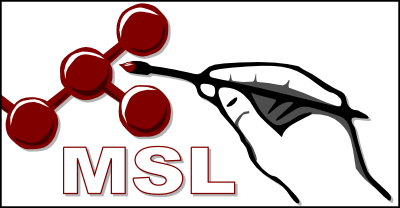Main Page
MSL: an open source C++ library for analysis, manipulation, modeling and design of macromolecules.
Contents
Philosophy
The main goal is to create a set of tools that enable the computational study of macromolecules with relative ease at all levels, from simple operations (for example, load a PDB and measure a distance or edit a dihedral) to complex applications (protein modeling or design).
The MSL library is not a program (although some applications are distributed) but a tool for scientist to code their own methods.
Features
Some of the features supported by the library are:
- Support for reading and writing PDB and CRD files.
- The ability of storing and switching between multiple atom coordinates, for conformational changes and rotameric representation of side chain conformational freedom.
- For protein design, the ability to build and store multiple residue identities (i.e. LEU, ILE, ALA) at a position and switch between them.
- Support for rotamer libraries.
- Transformations such as translations, rotations, and alignments.
- The CHARMM force field and other energy funtions.
- Support for CHARMM topology and parameter files.
- Structure building from scratch (using internal coordinates)
- Search algorithms such as Monte Carlo, Dead End Elimination, and Self Consistent Mean Field Monte Carlo.
- Local backbone sampling.
- Crystal lattice generation.
- A PyMOL Python Interface for calling MSL code from within PyMOL.
- A R Interface for calling arbitrary R algorithms or plotting routines from within MSL
- And more...
Documentation
The Documentation – currently still under construction – provides a description of the objects and of some distrubuted programs and utilites. A step by step tutorial is being assembled.
Status
Version 1.0 of MSL was released on July 8, 2012, which is suitable for production.
The libraries are in an advanced are in active development, and a development version is also available (use it at your own risk).
Source
The source code can be downloaded on SourceForge. Go to the Download page. ("To do" list).
Main development team:
- Alessandro Senes, Sabareesh Subraminiam, Ben Mueller, Dept. of Biochemistry, U. of Wisconsin-Madison, Senes Lab
- Dan Kulp, IAVI, Scripps Research Institute, La Jolla CA
- Jason Donald, Agrivida, Inc., Medford MA
- Brett Hannigan, U. of Pennsylvania, Genomics and Computational Biology Graduate Group
- Gevorg Grigoryan, Dept. of Computer Science, Dartmouth College, Hanover NH, Grigoryan Lab
We have applied to the Google Summer of Code 2013. Please see this page Google_Summer_of_Code_Ideas
Reference
Article published using MSL should cite:
Daniel W Kulp, Sabareesh Subramaniam, Jason E Donald, Brett T Hannigan, Benjamin K Mueller, Gevorg Grigoryan, Alessandro Senes
Structural informatics, modeling, and design with an open-source Molecular Software Library (MSL).
J Comput Chem: 2012, 33(20);1645-61
[PubMed:22565567]
##WORLDCAT## [DOI]
(I p)
MSL (including early versions) has been used in the following work:
